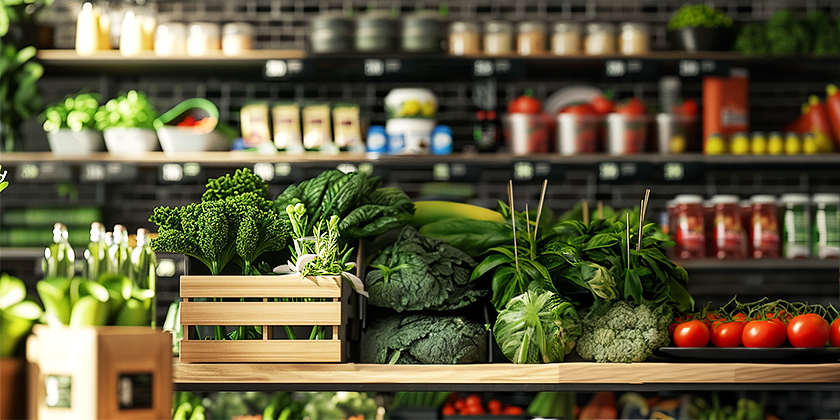The evolving landscape of retail requires innovative solutions to reach consumers effectively.
With the rapid growth of the digital world, retail businesses, particularly within the produce sector, need a solid marketing strategy.
This pushes businesses to rethink their traditional strategies and methods to stay competitive.
But with the vast range of digital marketing possibilities, where does one start?
This article will provide strategic insights tailored to the unique challenges of produce retailers.
Examining industry-specific factors, we will suggest actionable strategies to enhance consumer engagement and drive sales in an online platform.
Digital Marketing Strategies For Produce Retail
1. Use SEO optimization for organic online visibility.
SEO optimization is the most crucial tool for improving organic online visibility in an increasingly digital world.
Understanding how to effectively utilize SEO can significantly impact your business’s reach and the success of your digital marketing strategies for produce retail.
Given that the vast majority of online interactions begin with a simple search engine query, ensuring your business’s website is optimized to meet these search queries is vital.
Higher search engine rankings often lead to increased traffic on your website and, consequently, more potential customers.
SEO optimization can be likened to casting a wide net into the vast digital sea, thereby catching the attention of a more significant number of potential customers.
It is essential to note that SEO is not just about stuffing your website with the most common search queries or keywords; it’s about ensuring that your website’s content is high-quality and relevant.
Regularly updating your website’s content with new, relevant information can help keep your business at the forefront of search engine results.
There are various SEO tactics that you can employ to optimize your website, such as using relevant keywords, optimizing page titles and meta descriptions, and improving website navigation.
For produce retail, for instance, it’s important to highlight the freshness and quality of your products; hence, keywords like ‘fresh fruits’, ‘organic vegetables’, ‘locally-sourced produce’ could be used strategically throughout your website.
Remember, the key to effective SEO optimization is to be consistent and patient, as results may not be immediate.
Gaining organic online visibility is a gradual process that takes skill, effort, and time; but the results, when achieved, are highly rewarding and beneficial for the long-term success of your business.
SEO-friendly content persuades not just search engines but people too. The end-user experience can be significantly enhanced with an effective optimization strategy.
The right kind of SEO helps produce retailers to get found, get noticed, and get business in this digital-everything age.
To sum it up, a good understanding and implementation of SEO optimization can improve your website’s visibility, create a better user experience, and help you gain new customers, thus positively impacting your business performance.
By doing so, your business may even become a market leading authority and resource for produce retail in your locality and beyond.
2. Create Engaging Content About Product Freshness
In the digital age, content is king. To enhance the online visibility of your produce retail business, creating engaging content is not just important, it’s crucial.
As a produce retailer, one of the key selling points lies in the freshness of your products. Therefore, it’s an inherent part of your brand.
Your digital marketing strategy should, thus, majorly focus on increasing awareness about this core value proposition.
Crafting insightful content about product freshness not only educates your audience, but also induces trust in your brand.
This encompasses developing educational articles, blogs, Infographics, videos, and more that are centered around product freshness.
Moreover, showing consumers how they can identify fresh produce can provide them the confidence to make a purchase from you.
Additionally, it is imperative to emphasize on your sourcing methods, storage conditions, supply chain efficiency, time of harvest and more, to assert the freshness of your produce.
Also, demonstrate how fresh produce offers greater nutritional value and taste.
Provide practical tips on how to store fresh produce at home to maintain its freshness for a longer duration.
Telling stories about the farmers who grow your produce can not only humanize your brand, but also showcase the efforts taken to deliver fresh produce.
Also, adopt a consistent style in your content to align with your overall brand messaging.
Regularly updating content about product freshness will keep your audience engaged and educate them about seasonal produce as well.
Creating engaging content remains critical in digital marketing, and a data-driven approach will enable you to optimize your content strategy as audience preferences evolve.
Remember, every piece of content you publish contributes to your overall brand image and consumer perception.
Imbibe values of transparency, authenticity, and passion into your content to nurture a strong relationship with your customers.
3. Implement email marketing for loyal customer base.
Email marketing remains an essential tool for businesses despite the surge of social media platforms and the remarkable influence they have on digital marketing.
For produce retail businesses, strong customer relationships hold the key to business survival and progression so it makes sense to implement email marketing strategies that deepen these connections.
It’s essential to note that email marketing isn’t about sporadically bombarding your customer’s inbox with promotional messages, it requires careful planning and execution.
Email marketing as a digital marketing strategy goes beyond the usual product updates and sales promotions; it is an opportunity to share relevant content about product freshness and other topics that would interest your customers.
A well-organized email marketing strategy highlights your commitment to ensuring freshness in your produce, providing relevant updates and tips on how they can continue enjoying fresh, high-quality products.
Email marketing is a cost-effective way to build a loyal customer base by staying at the top of their mind and encouraging repeat purchases through regular, valued emails.
Implementing a successful email marketing strategy requires consistent communication of your brand’s values, ensuring that customers can trust the quality and freshness of your products each time they make a purchase.
The email content should be enticing enough to prompt the reader to take action, perhaps by using a strong call-to-action (CTA) button.
As much as possible, schedule your messages at regular intervals but avoid spamming your subscribers as this could lead to a loss of interest in your brand.
Consider segmenting your subscribers into various categories such as purchase frequency or interest, this would help in personalizing your messages and ensuring that every email is tailored to the recipient’s preference.
Utilizing an email marketing platform like MailChimp or Klaviyo helps to automate processes, effectively track email performance, manage your subscribers, and create rich, engaging content.
A great tip is to consider adding a personal touch such as using the recipient’s name or making special offers on their birthdays or during holidays, this goes a long way in making customers feel valued and appreciated.
To optimize your email marketing strategy for customer retention, consider implementing a customer loyalty program, offering exclusive discounts to subscribers, or giving priority access to fresh produce or new products to enrich the overall customer journey.
This digital marketing strategy serves as a gateway to enhancing your customer relationship management systems, thereby fueling customer retention and loyalty.
An effectively managed email marketing campaign not only promotes produce retail business growth but also fosters an ever-strengthening bond with your customers.
4. Utilize Social Media for Promotions and Contests
It’s no secret that in today’s digital era, social media holds immense power and potential, especially for retail businesses.
The various platforms provide an excellent opportunity to connect and interact with consumers on a personal level.
Therefore, integrating social media in your digital marketing strategy holds the key to heightened brand visibility and improved customer engagement.
Particularly for a produce retail business, social media can be a valuable tool to showcase the freshness and quality of your offerings.
One of the most prominent ways to do so is by organizing online promotions and contests.
A well-planned social media contest can stimulate online engagement, ultimately leading to increased visibility and enhanced brand recall.
Apart from this, such strategies also work wonders in attracting potential new customers and fostering a sense of community and brand loyalty among existing ones.
You can frame your contests around customer-generated content like recipe videos or photos using your produce, favorite grocery shopping tips, or healthy eating practices.
Such a move not only promotes your product but also encourages users to interact with your brand in a more meaningful and personal way.
To make promotions and contests more effective, you can incorporate rewards and incentives, such as discounts on purchases, unique brand experiences, or specific product giveaways.
This keeps your current followers excited about your brand and also appeals to potential new customers.
Moreover, promoting user-generated content showcases your commitment to your customer community and makes them feel valued and important.
While implementing such tactics, it’s crucial to adopt a platform-specific approach.
Each social media platform attracts a different audience type and, therefore, requires a unique strategy catered to its user habits and preferences.
Figure out where your target demographic is active the most, and focus your social media marketing strategy there.
Consider all these key points, and you can successfully leverage social media for promotions and contests as part of your digital marketing strategy for your produce retail business.
5. Target local market with geofenced ads.
One of the most effective digital marketing strategies that produce retail businesses can utilize is targeting the local market through geofenced ads.
The main objective of geofenced ads is to deliver personalized content to local shoppers as soon as they enter a predefined geographic area.
What makes geofencing a powerful tool particularly for produce retailers is its ability to leverage location-based data to tailor offers, enhance user engagement and drive store traffic.
Through geofenced ads, businesses can target consumers who have already shown interest in fresh produce by visiting-related stores or searched for related information online.
This strategy not only allows for more precise targeting but also makes it possible to offer timely and relevant promotions, hence increasing the chances of conversion.
Creating geofenced ad campaigns, however, requires a careful understanding of not only the local market dynamics but also the needs and preferences of the target audience.
For instance, a produce retailer might consider running promotions during farmers markets, celebrating local produce, and championing a ‘support local’ message to resonate with the community and encourage local consumption.
Running such targeted campaigns also requires resources and an in-depth understanding of location-based technology.
However, many online advertising platforms such as Facebook and Google provide easy-to-use tools to implement geofenced ad campaigns even for businesses with limited experience in digital marketing.
To measure the effectiveness of geofenced ads, businesses need to track key performance indicators such as click-through rates, store visits, and even purchases.
By doing so, organizations can understand which strategies are working, which need improvement and adjust their campaigns accordingly.
Another important aspect that businesses should consider while launching geofenced ads is the privacy of users.
Ensuring that customers’ location data is collected and stored responsibly, and in accordance with local laws and regulations, can help to maintain trust and foster long-term relationships with customers.
From the perspective of a produce retailer, geofenced ads can act as a powerful tool to attract local customers and encourage repeat visits enhancing overall revenue.
In conclusion, while geofencing may have its challenges, when implemented effectively it can significantly enhance a produce retailer’s ability to connect with and nurture their local customer base.
The Bottom Line
Maintaining a strong online presence is essential in today’s digital age, underpinning crucial methods such as SEO optimization and social media marketing.
Engaging content about product freshness becomes essential in drawing in and retaining customers, while strategies like email marketing fosters a loyal customer base.
Finally, targeting local markets with geofenced ads possesses the potential to boost profits and visibility in local communities.
Thus, a robust and layered marketing strategy, marked by digital approaches and engaging content, proves to be key in connecting with customers and enhancing business success.




